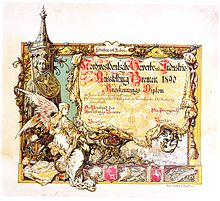Otto Bollhagen
Friedrich Ferdinand Otto Bollhagen , known as Otto Bollhagen sen. (* September 16, 1861 in Wesenberg (Mecklenburg) ; † September 5, 1924 in Bremen ) was a room and decoration painter. He became known as a painter of industrial landscapes .

biography
Otto Bollhagen Sr. was the second son of a total of 15 children of master tailor Johann Carl Christian Bollhagen from Mecklenburg-Strelitz and his wife Georgine Sophia Dorothea, née. Knuth, born. Bollhagen spent his childhood relatively closed. He attended the Wesenberg elementary and community school. The family did not have enough money for training at the Neustrelitz grammar school. His talent for drawing shows up early on. In 1875 he came to Berlin , where, living with an aunt, he completed an apprenticeship as a room and decorative painter. Here, too, his artistic abilities were soon noticed. a. manifested in the award for best apprentice. Since studying at the art academy was not possible for financial reasons, Bollhagen also attended courses at the teaching institute of the Berlin Museum of Decorative Arts .
After completing his apprenticeship, he took on various odd jobs between 1879 and 1883, such as designing carpet and wallpaper samples. In 1883 he went to Hamburg , but soon returned to Berlin and served as a soldier in Ratzeburg from 1883 to 1885 . Further stays in Berlin and Hamburg followed until he finally moved to Bremen in 1886 . Here he first worked in the J. Neumark painting company for whom he took on the decorative design of ships for the North German Lloyd . a. he became acquainted with the prominent architect Johann Georg Poppe . In 1892 he founded his own studio and worked with 50–70 employees as a decorative painter for numerous public buildings in Bremen, such as the Municipal Museum , the Regional Court and the New Town Hall . On the side he also created caricatures, postcards, posters and other commercial graphics .
1903–1904, Bollhagen had a villa built at Parkallee 205 based on a design by Fritz Dunkel . A building that already exists behind it is being converted into a studio. From 1904, the painter Fritz Jacobsen ran the studio in Parkallee and became a partner in 1911, but went into business for himself in 1921.
In the period around the First World War , which was accompanied by a significant decline in orders, Bollhagen devoted himself to industrial painting and created paintings and illustrations for companies such as Krupp , Bayer , AG Weser, but also for the Prussian Railway Museum in Berlin and the World Exhibition in Brussels in 1910 . After the war he continued his business on a smaller scale. From 1924 his son Otto Bollhagen jun. the business that still exists today and is now run by a great-grandson of Otto Bollhagen.
Part of Otto Bollhagen's artistic estate is kept in the Focke Museum in Bremen .
literature
- Otto Bollhagen, Bremen, in commemoration , Cologne: Beyer & Schmeisser, 1925.
- Lars U. Scholl: The industrial painter Otto Bollhagen: 1861-1924 , Herford: Koehler, 1992.
- Herbert Black Forest : The Great Bremen Lexicon . 2nd, updated, revised and expanded edition. Edition Temmen, Bremen 2003, ISBN 3-86108-693-X .
Web links
- Literature about Otto Bollhagen in the state bibliography MV
- Otto Bollhagen's biography and picture gallery on the Bollhagen painting company website
| personal data | |
|---|---|
| SURNAME | Bollhagen, Otto |
| ALTERNATIVE NAMES | Bollhagen, Otto sen .; Bollhagen, Friedrich Ferdinand Otto (full name) |
| BRIEF DESCRIPTION | German room and decoration painter |
| DATE OF BIRTH | September 16, 1861 |
| PLACE OF BIRTH | Wesenberg (Mecklenburg) |
| DATE OF DEATH | September 5, 1924 |
| Place of death | Bremen |
